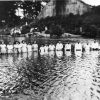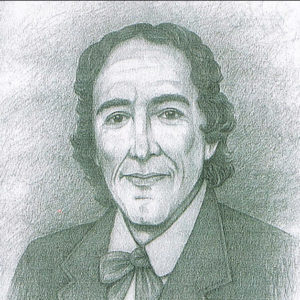calsfoundation@cals.org
David Orr (1798–1847)
David Orr was one of the earliest preachers in northeastern Arkansas, settling in the state in about 1828. During his time in the region, he started nine different churches and founded the Spring River and Rocky Bayou Baptist Associations in the Ozark Mountains east of the White River. Although Orr was exclusively a Baptist preacher, he was also interested in modern-day religious revelations, such as those of the Mormons and New York farmer William Miller.
After his birth in Bourbon County, Kentucky, in 1798, Orr lived near Cincinnati, Ohio, seventy miles away from his birthplace. While in Cincinnati, he was influenced and baptized by Jeremiah Vardeman, a fiery revivalist preacher during the Second Great Awakening. Orr married Eliza Caldwell in 1821 and then moved to Missouri in 1823 and began preaching. According to historian Walter McLeod, Orr and his wife eventually had eleven children.
In 1827, Orr began to commute back and forth from southern Missouri into Arkansas, going as far south as Little Rock (Pulaski County). The following year, he committed to ministry in Arkansas full time. There were two elderly preachers in the territory already, but their poor health limited their efforts. Orr baptized eleven people in his first week. Orr’s sources of funding varied. Between 1832 and 1839, he received support from the American Baptist Home Mission Society of New York and Ladies’ Western Association of Providence, Rhode Island. Later in life, Orr supported his family by farming in addition to his ministry.
Accounts vary regarding the level of Orr’s education. Historian R. S. Duncan states that Orr was a graduate of an unknown institution, while historian Brooks Blevins states that, like other frontier preachers, Orr possessed little formal schooling. All agree, however, that he was an energetic and inquisitive person. One congregant cited in author J. S. Rogers’s sketch said that “[Orr’s] education was superior to that of his hearers,” giving him “unlimited influence” in the area. Orr thus became a teacher as well as a preacher.
Orr was often involved in politics. During his time in Missouri, he joined the new state legislature, which, according to author R. S. Duncan, had a “tendency to draw his mind from [preaching]” and “gave rise to considerable dissatisfaction among his brethren.” When he moved to Arkansas, Orr was part of the Territorial Legislature, where he was given the nickname “David the High Priest.”
Orr could be a controversial figure. In 1829, two men were charged with disturbing a worship gathering by “profusely swearing and using indecent gestures” toward Orr. Orr himself was involved in several court cases, including one in 1830 in which he was charged with “trover and conversion” for supposedly trespassing and stealing a horse, and another in 1839 for charges of assault and battery. Debts also brought Orr to court in 1839, 1843, and 1844.
Later in life, Orr became curious about the teachings of Joseph Smith and his Church of Jesus Christ of Latter-day Saints (sometimes shortened to the LDS Church, Mormon Church, or Church of Jesus Christ). In 1841, a Mormon preacher came to speak at a meetinghouse in western Lawrence County. When Orr discovered that several men were blocking the Mormon man from entering, he confronted one of them, and a fight ensued. In 1843, Orr wrote a letter to Joseph Smith declaring himself “a stranger” to Smith personally but “not so with relation to your sayings, and doings, as a man of God.” He went on to ask about the Kinderhook plates (forgeries later revealed to have been created for testing Joseph Smith’s revelatory abilities) and the predictions of William Miller, a Baptist preacher who predicted that the Second Coming of Christ would occur in 1843. These modern-day revelations, though later proven false, gained much contemporary attention.
Orr retired from the ministry in 1844 and moved to nearby Fulton County. Orr died of tuberculosis in 1847, leaving behind his wife and many children.
For additional information:
Blevins, Brooks. Hill Folks: A History of Arkansas Ozarkers & Their Image. Chapel Hill: University of North Carolina Press, 2002.
Duncan, Robert Samuel. A History of the Baptists in Missouri. St. Louis: Scammell, 1882. Online at https://archive.org/details/historyofbaptist00dunc (accessed April 20, 2017).
Harthorn, Edward. “‘Pushing him back over the pulpit’: David Orr and Religious Conflict in Early Arkansas.” Lawrence County Historical Journal (2017, no. 1): 7–25.
“Letter from David Orr to Joseph Smith, June 14, 1843.” Archives of Church of Jesus Christ of Latter-Day Saints Church History Library, Salt Lake City, Utah.
McLeod, Walter E. “New Hope Baptist Church.” Lawrence County Historical Society Journal 14 (Spring 1991): 8–13.
Rogers, James Sterling. History of Arkansas Baptists. Little Rock: Arkansas Baptist State Convention, 1948.
Edward Harthorn
Arkansas State University
 Louisiana Purchase through Early Statehood, 1803 through 1860
Louisiana Purchase through Early Statehood, 1803 through 1860 Religion
Religion David Orr
David Orr 




Comments
No comments on this entry yet.